 With the Christmas shopping season officially starting this weekend the new year is not far off. Are you now or have you already prepared your budget for 2014. What is on your social marketing wish list? Or to be a bit broader in scope, your Digital marketing wish list.
With the Christmas shopping season officially starting this weekend the new year is not far off. Are you now or have you already prepared your budget for 2014. What is on your social marketing wish list? Or to be a bit broader in scope, your Digital marketing wish list.
Are there things that you feel would improve the overall performance of your online initiatives? Does upper management understand the importance of digital marketing in today’s marketplace or are you still in an uphill battle in trying to convince them to allocate more resources?
Â
Your Social Marketing Holiday Wish List
By Elisabeth MichaudThe new year is right around the corner, and it’s time to pull together your plan. You’ve been very, very good (at social marketing) in 2013, so now’s your chance to ask your boss for the things you need in order to make 2014 even better. Here, we’ve outlined the 5 things you absolutely MUST include on your social marketing wish list, and how to explain them to your boss so she’ll know exactly what value they’ll bring to your brand over the next 12 months.
1. Budget (or, more budget) for promoted social media posts
You may be spending to promote organic content already (especially given that organic posts for brand pages reach only about 10% of the page’s audience), or you may be planning to start, but either way, you’ll need a bigger budget for it over the next 12 months. With promoted content options now available on Facebook, Twitter, LinkedIn, and even Pinterest and Instagram, a social media manager needs access to some of her brand’s ad budget. Ask your boss to help you work with your ad agency or in-house team to get control over some of those marketing dollars! You’re in a great position to know where to spend; you know what posts perform well, what type of content your fans tend to enjoy, and where putting money behind your day-to-day content efforts can really pay off. So ask your boss for a chance to put your money where your social is!
2. Some Santa’s Helpers
Is your brand getting bigger and bigger in social thanks to your hard work? Are you becoming overwhelmed with trying to be everywhere all the time, and maximizing return on time (and money) invested in social? Maybe it’s time to ask for some additional help! Argue your case with metrics that show your achievements in 2013 and how they’ve benefited the brand (think: fan/follower growth leading to increased awareness, a higher number of average pageviews on your site from your social audience in Google Analytics, growth in impressions, increased engagement metrics, and more), then share a plan for adding more hands to your social marketing team and what you can expect to achieve with that extra help. A potential bonus? A promotion may be in the cards for you in early 2014 when new team members come aboard.
3. Design essentials: stock photography credits, your own Photoshop license, or maybe even a graphic designer
We’ve cited the importance of images and video in social media many times, and these will only continue to grow in significance in the coming year. You probably already have the makings of some great visual content, whether your brand is mostly B2C or B2B, but you may not yet be using those resources to the fullest. A lot of social media marketers are great writers—words are how we communicate with our audience!—but not all of us are great with imagery and graphics. To play in 2014’s social media world, you need photos and videos to fully take advantage of platforms like Instagram, Pinterest, Tumblr, Vine and to produce the best-performing content on Facebook and Twitter. You’ll need access to graphic resources like stock photography, Photoshop, or a graphic designer with time dedicated to helping the social team. Show your boss why it’s important by sharing stats on the social networks your audience is most active on, and point to the effectiveness of images and video on some of the biggest platforms: Facebook, Twitter and YouTube.
4. The ability to act in real (or near-real) time
Does your boss need to approve every tweet before you send or schedule it? Does every piece of content need to be vetted by multiple departments? This item is a big ask, but you need your boss or your coworkers’ trust—trust we know you’ve earned this year—to post more freely, in a more timely manner. The bonus for your brand? You’ll be able to produce content more quickly, meaning you can keep up with social in real time. While not every post will be created on the spot, there’s space for both planned and spontaneous content in your social strategy. Talk to your boss or PR department about what the advantages of each type are, and try to use the opportunity to set up a more real-time friendly environment in social. If brands like Oreo can do it, why not yours?
5. A really great social media marketing tool
Have you been cobbling together a bunch of different free and paid social media tools in order to get the information you need about ROI, engagement, fan growth, and more? Is it really working for you? If your annual contract(s) for your paid tools are about to run out, this is a great time to reevaluate and hunt for something new—a better tool or set of tools than what you’re currently using. Depending on your marketing goals, this could be a real-time social media marketing tool like uberVU, a better CRM system, an upgraded website analytics tool, or a combination of these things. Does your top pick have a bigger price tag than what you’re currently using? Show your boss how it’ll make you more productive and allow you to complete daily tasks faster, leaving you additional time to grow the business.
 Many sales people are familiar with the concept of the “sales funnel,†with the idea that every sale starts with a large pool of prospects. Then they are eventually narrowed down by the various steps of the sales process (qualification, presentations, proposals, etc.) leading to a much smaller number of customers who actually decide to buy and close the deal.
Many sales people are familiar with the concept of the “sales funnel,†with the idea that every sale starts with a large pool of prospects. Then they are eventually narrowed down by the various steps of the sales process (qualification, presentations, proposals, etc.) leading to a much smaller number of customers who actually decide to buy and close the deal.
A big part of success in managing your sales leads is developing a better way to understand how you should be managing your sales funnel.
Below are a few of the biggest mistakes that small business leaders tend to make in managing their sales funnels – and ideas on how you can get better results.
Managing Your Sales Funnel Mistake #1:
No Balance Between Lead Generation / Lead Management
Many companies make the mistake of thinking that they can get better sales results just by constantly engaging in lead generation activities to “dump more leads into the funnel.†But lead generation alone is not enough.
You also need to focus on your lead management activities:
- Ranking
- Sorting
- Nurturing
- Following up on your existing sales leads
You can almost always improve your sales results by doing a better job of managing the sales leads you already have. Instead of constantly hunting for more and more sales leads.
Mistake #2:
Focusing on CRM Technology Instead of Your Sales Process
Many small businesses make the mistake of investing in expensive customer relationship management (CRM) software but without a clear understanding of how they want to use the CRM software to improve their sales process.
CRM technology can be a valuable tool, but it cannot replace a smart strategy for understanding and adjusting your sales activities to line up with your biggest priorities in your sales process.
For example, you as a small business leader, need to understand what is happening at every stage of your sales process. Are you failing to generate enough appointments during your initial contacts with new sales leads? Are your sales appointments failing to result in enough follow-up sales presentations? Where in the sales process are you having the most difficulty, and what can you do differently?
These are the questions that CRM tools can help you answer. But you can’t rely solely on technology to do the hard work of identifying and fixing the problems.
Mistake #3:
Not Getting Proper Sales Training
Sales training is not just for new hires. Small business owners need motivation, coaching and a clear idea of what they’re selling and how to adjust to customers’ changing needs and expectations..
Mistake #4:
Not Measuring Each Stage of Your Sales Funnel
Many organizations focus too much on their final deal closing ratios, and don’t pay enough attention to the conversion ratios that lead up to the final negotiations with the buyer.
Take a look at all stages of your sales process and measure your success rate at each stage. For example, out of 100 sales leads, how many will agree to an initial appointment? How many of those appointments lead to a more extensive sales presentation? Where in your sales process are the biggest successes and the biggest opportunities to improve?
Managing your sales funnel needs to be part of an ongoing effort to see what is happening within your sales process and adjusting along the way.
If you have a clear understanding of where your challenges are coming from, which parts of the process need to improve, and constantly coach your sales team to improve their efforts at each stage of your sales funnel, you will start to see a better result in the most important number of all – sales.
By Al Davidson
Â
Sales Funnel Photo via Shutterstock
Â
Activating Employees In Social: Is Your Organization Ready?
Tags:
 Your employees are one of the best (and often underutilized) tools you have in your social toolkit. Your employees can help amplify your brand’s messages and help you tell the brand’s story. Plus – your employees’ messages will be more trusted than your brand messages. 90% of consumers trust recommendation from people they know and only 14% trust advertising. When it comes to powering employees in social, it seems like a no brainer.
Your employees are one of the best (and often underutilized) tools you have in your social toolkit. Your employees can help amplify your brand’s messages and help you tell the brand’s story. Plus – your employees’ messages will be more trusted than your brand messages. 90% of consumers trust recommendation from people they know and only 14% trust advertising. When it comes to powering employees in social, it seems like a no brainer.
Is your company ready to activate employees to be brand advocates?
The Social Arts and Science Institute (SASI) has put together an Employee Activation Maturity Assessment that outlines the critical competencies companies need to be successful with employee advocates.
1. Policy & Governance. It’s critical that companies have social media policies in place before rolling out employee advocate program. What role are your employees going to play in your overall corporate social media strategy? How are you going to manage and support them? Social media policy is important to help mitigate the potential risk associated with setting teams free to engage in social channels as well as help employees feel empowered to engage on social.
2. Training. Social media training is a critical part of any employee advocate program. A recent survey (http://marketingland.com/survey-71-of-companies-concerned-about-social-media-risks-only-36-do-social-media-training-60212) revealed that 71% of executives said that their company was concerned with potential risks posed by social media. Yet only 36% claimed that their organizations had social media training. It’s important to train employees on social media best practices, company policies and strategy. Similarly to policies and governance, training employees in social media can help mitigate risk as well as provide employees with the skills they need to be successful.
3. Metrics & Measurement. As with any initiative it’s important that companies are set up to measure business impact of their Employee Advocate Program. Powering thousands of employees in social channels will drive lots of social shares and helping the organization reach new audiences and prospective new customers. Because of such, it’s critical to track and measure the KPIs that matter most so that you can prove value and deliver results.
4. Tools & Technology. In order to activate employees in social channels, it’s important that they have access to the tools they need to be successful. At the most basic level this means providing access to consumer tools to facilitate social engagement and sharing. Organizations that have truly made a commitment to social will actually provide employees with access to enterprise tools to allow employees to listen to and engage with relevant conversations and topics at a more granular level.
5. Leadership. Arguably one of the most important parts for successful Employee Advocate Program launch is executive buy in. The most successful social companies not only have buy in from leadership, but the executives are social themselves, leading by example.
For more details view the full chart below.
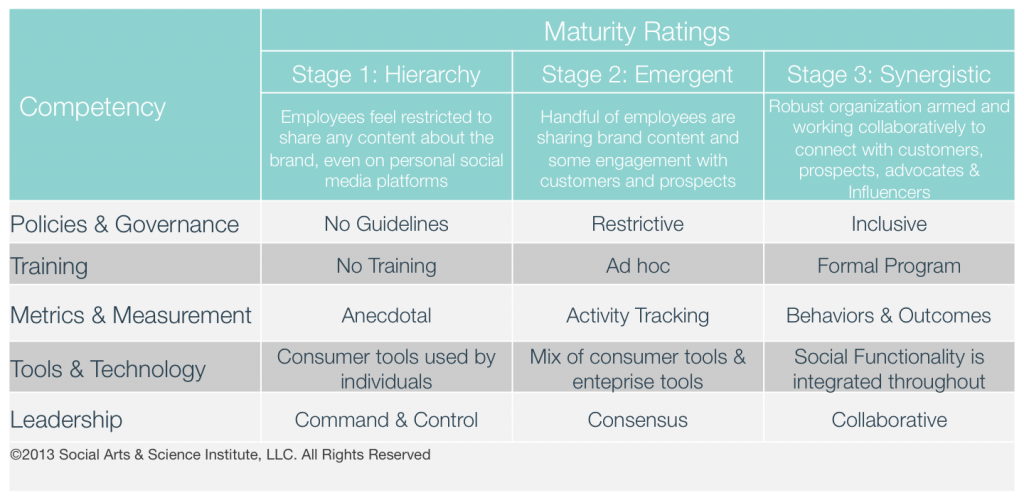
Relevant Articles:
Are You Ignoring your Best Brand Advocates?
Must Have Social Marketing Tools
Â
Â
 Only a couple of years ago, pundits were predicting an end to email. But instead of fading away, there’s been ever-increasing email volume and usage. Rather than being replaced by Facebook and Twitter streams, email is actually becoming a stream itself.
Only a couple of years ago, pundits were predicting an end to email. But instead of fading away, there’s been ever-increasing email volume and usage. Rather than being replaced by Facebook and Twitter streams, email is actually becoming a stream itself.
Mail systems are evolving to match the new volume of email, and users will increasingly see only algorithmically vetted emails. Some other emails may be shown below the vetted email, and the rest will flow away into temporal oblivion, just like uninteresting social posts from a few hours ago.
Implications for marketers are significant. The days of the average AOL or Yahoo! mail user scrolling through every email in their inbox are rapidly fading. Email has been especially important in e-commerce sales and customer re-engagement. For e-commerce in particular, email marketing exceeds the performance of social advertising. Large-volume email senders will need to make a greater effort to send emails that are both personalized and interesting to the recipient.
The email tsunami problem is pervasive. Several Silicon Valley folks have already committed the unfortunately termed “email suicide,†where they give up on reading unread email and start anew. Others are adding email auto-responders stating that they will not necessarily see email. New vendors such as SendGrid have helped bring on the deluge by dramatically lowering the price of sending volume email and democratizing access with simplified onboarding and easy developer APIs.
Google has added several features to Gmail in an attempt to add some order to the chaos of email. The changes will effect both email users and marketers. With Gmail features like Priority Inbox, Gmail Tabs, and Circles, users are increasingly engaging only with algorithmically vetted email from senders they know. Priority Inbox is only a satisfactory product and needs to evolve to automatically mark as “important†email from senders that a recipient repeatedly opens, especially if the recipient replies. Next-generation email clients like Inky go as far as sorting email by relevance rather than date.
 For marketers, sending a ton of email without any user engagement will soon become counterproductive. For each type of volume sender, a new balance will have to be found between sending numerous emails and still achieving desired “open rates†and “clickthroughs†— mechanisms by which an email provider like Google can detect whether or not the email is of interest to a user. Much like how “edge rank†increases for Facebook posts when the people like, share or comment on it, “mail rank†will be an increasingly important benchmark for email marketers to measure their effectiveness.
For marketers, sending a ton of email without any user engagement will soon become counterproductive. For each type of volume sender, a new balance will have to be found between sending numerous emails and still achieving desired “open rates†and “clickthroughs†— mechanisms by which an email provider like Google can detect whether or not the email is of interest to a user. Much like how “edge rank†increases for Facebook posts when the people like, share or comment on it, “mail rank†will be an increasingly important benchmark for email marketers to measure their effectiveness.
At CBS Interactive, we send over 200 million emails a month, ranging from news summaries to personalized fantasy sports updates, to an audience of 270 million unique users. We have corporate standards and systems to ensure that recipients can easily unsubscribe from unwanted emails. However, given these upcoming changes, we will need to look at overall open rates from a particular property and begin to proactively prune users that have no interest in emails we send.
 The shift to email as a stream will have personal implications as well. People may have to be introduced via a mutual party rather than sending a cold email, especially if the sender has sent numerous emails that have not entailed or received a response. Even personal emails from people you know may soon be treated like a Facebook or Twitter post, where a user either immediately responds, such as with a Facebook like or comment, or instead lets it flow into the ether. Much like social posts, senders will likely shift toward keeping email messages short and to the point.
The shift to email as a stream will have personal implications as well. People may have to be introduced via a mutual party rather than sending a cold email, especially if the sender has sent numerous emails that have not entailed or received a response. Even personal emails from people you know may soon be treated like a Facebook or Twitter post, where a user either immediately responds, such as with a Facebook like or comment, or instead lets it flow into the ether. Much like social posts, senders will likely shift toward keeping email messages short and to the point.
Facebook and Twitter both have nascent but unique takes on messaging. Facebook messages that are not from one of your friends go into an “other†folder that is rarely read. Twitter direct messages can only be sent to people who follow the sender, although Twitter is experimenting with opening this up a bit.
Stream-oriented companies like Facebook and Twitter essentially charge brands to target their own customers by allowing brands to purchase promoted posts for their fans and followers. Email providers may soon sell “promoted emails†where a marketer can target a user in their priority inbox. Users may revolt, but in the end they are getting email for free, so it will be hard to complain. Email has become a stream, and as the adage goes, when you’re not paying, you’re the product.
 Peter Yared is the CTO/CIO at CBS Interactive. Follow him on Twitter @peteryared.
[Image: Shutterstock]
Marketers who get inundated with these types of stories get an inflated view of the market penetration of new technologies. But if there is a lot of hot air in these numbers, what can we say about the actual adoption rates of marketing automation software? We delved into this question in our just-published eBook, Marketing Automation: An Industry Overview.
We looked at the total number of businesses in the U.S. but took out the smallest of enterprises – those with not even a single employee. The table below shows marketing automation software use by size of company. Keep in mind there are also over 20 million businesses with zero employees – freelancers, consultants, and other self-employed people, many of whom use email marketing software and could be ripe to upgrade to marketing automation platforms.
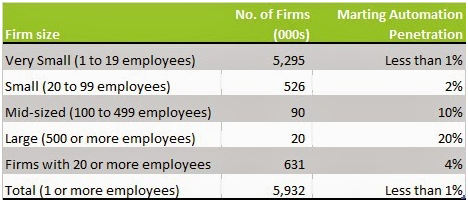
Â
In his book, Crossing the Chasm, Geoffrey A. Moore describes a technology lifecycle in which the adoption or acceptance of a new product or innovation proceeds according to the demographic and psychological characteristics of defined adopter groups. According to Moore’s model, the first group of people to use a new product is called “innovators,†followed by “early adopters.†The “chasm†is the crucial period during which a product is either adopted broadly, or remains part of a niche market (or fails). The “early majority†and “late majority†then adopt the product, followed by the last group,
known as “laggards.â€
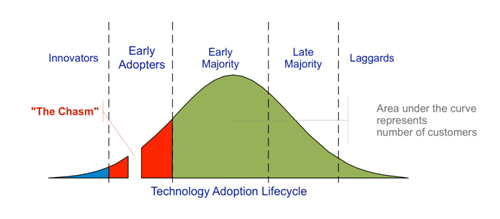
Â
If this model is applied to the marketing automation sector, it becomes evident that, although the technology is still early in its lifecycle, the chasm is indeed being crossed – at least among large companies.
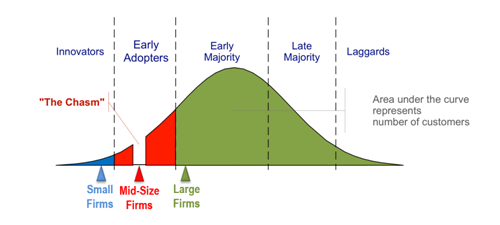
Â
Figure 2 shows that marketing automation among large firms has crossed the chasm and has now reached the Early Majority stage. By contrast, mid-sized firms are just now crossing the chasm while small firms are still in the Innovators stage. This explains the growing number of marketing automation vendors seeking to gain a foothold into this market, as well as the substantial venture capital the sector has attracted.
What’s especially interesting is why companies are spending the time and effort to cross the chasm. Is the payoff worth the risk? You can read about the compelling case for marketing automation, including capabilities and benefits, in our brand-new Marketing Automation: An Industry Overview eBook.
Dan Freeman of Marketing Growth Strategies has over 25 years of senior level management consulting and marketing experience, working with Fortune 100 organizations as well as small and mid-sized businesses. Dan combines hands-on management experience with advanced knowledge of marketing technologies and all aspects of digital marketing in order to help clients find, get, and keep the right customers to grow their top line.
OK, so you’re hearing a lot about marketing automation. Getting tweets and emails and reading blogs and white papers about how it’s simplifying and transforming the lives of marketers. From all this hype, you might have the impression that everyone who’s anyone in marketing is using marketing automation software. I recently saw a headline claiming that 46 percent of B2B companies use marketing automation. When I read the details, it was clear that the 46 percent represented those that responded to a marketing automation survey. Who responds to a marketing automation survey? Usually those that use marketing automation software. Duh! This was not even remotely representative of the marketplace as a whole.
Marketers who get inundated with these types of stories get an inflated view of the market penetration of new technologies. But if there is a lot of hot air in these numbers, what can we say about the actual adoption rates of marketing automation software? We delved into this question in our just-published eBook, Marketing Automation: An Industry Overview.
We looked at the total number of businesses in the U.S. but took out the smallest of enterprises – those with not even a single employee. The table below shows marketing automation software use by size of company. Keep in mind there are also over 20 million businesses with zero employees – freelancers, consultants, and other self-employed people, many of whom use email marketing software and could be ripe to upgrade to marketing automation platforms.
 All told, there are roughly 50,000 marketing automation installations—less than 1 percent of the nearly 6 million businesses with at least 1 employee. It’s interesting to note that even for the 631,000 companies with 20 or more employees, penetration only stands at about 4 percent today.
All told, there are roughly 50,000 marketing automation installations—less than 1 percent of the nearly 6 million businesses with at least 1 employee. It’s interesting to note that even for the 631,000 companies with 20 or more employees, penetration only stands at about 4 percent today.
In his book, Crossing the Chasm, Geoffrey A. Moore describes a technology lifecycle in which the adoption or acceptance of a new product or innovation proceeds according to the demographic and psychological characteristics of defined adopter groups. According to Moore’s model, the first group of people to use a new product is called “innovators,†followed by “early adopters.†The “chasm†is the crucial period during which a product is either adopted broadly, or remains part of a niche market (or fails). The “early majority†and “late majority†then adopt the product, followed by the last group,
known as “laggards.â€
 Figure 1: Technology Adoption Lifecycle from Crossing the Chasm
Figure 1: Technology Adoption Lifecycle from Crossing the Chasm
If this model is applied to the marketing automation sector, it becomes evident that, although the technology is still early in its lifecycle, the chasm is indeed being crossed – at least among large companies.
 Figure 2: Current State of Marketing Automation Adoption by Firm Size
Figure 2: Current State of Marketing Automation Adoption by Firm Size
Figure 2 shows that marketing automation among large firms has crossed the chasm and has now reached the Early Majority stage. By contrast, mid-sized firms are just now crossing the chasm while small firms are still in the Innovators stage. This explains the growing number of marketing automation vendors seeking to gain a foothold into this market, as well as the substantial venture capital the sector has attracted.
What’s especially interesting is why companies are spending the time and effort to cross the chasm. Is the payoff worth the risk? You can read about the compelling case for marketing automation, including capabilities and benefits, in our brand-new Marketing Automation: An Industry Overview eBook.
Dan Freeman of Marketing Growth Strategies has over 25 years of senior level management consulting and marketing experience, working with Fortune 100 organizations as well as small and mid-sized businesses. Dan combines hands-on management experience with advanced knowledge of marketing technologies and all aspects of digital marketing in order to help clients find, get, and keep the right customers to grow their top line.
 Drip marketing is a term to describe a series of autoresponder emails that are sent out in a specified time interval to customers who opt into your website.
Drip marketing is a term to describe a series of autoresponder emails that are sent out in a specified time interval to customers who opt into your website.
This is a fairly common practice. The email may be to welcome you, to educate you about products, or to offer you discounts, but the goal is to convert prospects to customers and customers to repeat customers.
I’m writing this from Disney World. This is my first time coming here, and I was a bit taken aback that I have to walk my kids through a gift shop every time that they eat or take part in an event at the resort or at the parks.
Essentially this is the goal of your drip marketing campaign, since your opt-in customers visit their email regularly you are setting up a gift shop (of sorts) through your email.
Just as Disney has optimized their merchandising to make sure my daughter sees princesses and my son sees monsters each time they pass through, you must maximize the effectiveness of your drip marketing campaigns to better convert these customers.
In this post I’m going to showcase four case studies, showing how some businesses have optimized their drip marketing campaigns, how they decide on frequency, decide on content, and how one company creatively segmented their opt-ins to generate a lot of business.
1. Dynamic Search gets a double-digit increase in click-through
Search agency Dynamic Search implemented an eleven episode drip campaign over the course of the nine months after opt-in. Principal Asher Elram admits to not being a huge believer in email marketing prior to implementation, but by executing their drip campaign click-through has increased between 12 and 18%. Results like that will quickly restore your faith in email as a marketing tactic.
Eleven emails isn’t a random number. You can be sure that Dynamic Search A/B tested their frequency and timing quite thoroughly. However, before testing timing marketing expert Tommy Walker recommends A/B testing subjects lines. This makes intuitive sense: it’s important that Disney gets its princesses and monsters at a three-year old eye level before trying to decide the best times to do anything else.
The recommendation to A/B test should be extended to all content and its parameters. Email is ideal because you can isolate test groups and customer segments to get a good data about what works and what doesn’t.
2. Studentbeans mixes dynamic content with static to increase revenue 13%
UK website studentbeans.com offers deals and advice for college students. They get a lot of web traffic (to the tune of six million visits a year) but were having trouble converting that traffic into click-through and sales.
What they decided to do was to introduce dynamic content into their static drip campaign, for example augmenting their prescribed content with a current offer, discount or deal. The results were extraordinary: open rates increased 66% and revenue increased 13%.
3. Iron Tribe Fitness qualifies and converts 50% of online prospects
One key to drip campaigns is to create high-value content.
Iron Tribe Fitness is a high-end fitness gym. It’s not like the gym most people go to – users have to commit quite a bit of time and resource (an average user spends $2000 during their time with ITF). Before implementing a drip campaign to their marketing, most members were acquired offline.
ITF implemented a drip campaign which sent opt-in prospects eleven emails in eighteen days. These emails educated the prospects about ITF and qualified them as proper prospects for their niche (high-end) product.
The result? About half of opt-in prospects became members (to the tune of $2000 revenue each). Did I mention that Iron Tribe Fitness is a franchise?
Similarly, the Moz.com website uses an autoresponse campaign to teach new users how to use their tools. While this may sound somewhat mundane, these educational emails actually drove a million dollars in revenue in four months by retaining new users.
Smileycookie segments to increase sales 29%
Cookie selling website smileycookie.com noted a significant problem with cart abandonment. They implemented a drip campaign specific to users who abandoned their cart (note that they had to add some controls on their site to capture emails in advance of users leaving cookies in their virtual carts).
Their campaign had three parts: an immediate email, a second email twenty-three hours later offering a discount and a third email four days later offering an even larger discount. The results? The open rate of the first two emails is greater than 50% (usual open rate is 20%). CTR for email one is 28%, two is 16% and three is 6%, meaning that more than a quarter of people who abandoned their cart went back to the site afterwards.
Not a lot of businesses have the scale or customer-affinity that Disney has. Just as I’m going to walk through a dozen gift shops today with my kids picking up random items before being thwarted by my “no†(which is sometimes thwarted by my wife’s “yesâ€), your customers have given you the opportunity to educate them, to offer them discounts, and to convert them by giving you their email address.
Drip campaigns are a low-cost way to do this, provided you do it thoughtfully.
Jim Dougherty is an expert on social media and technology who blogs at Leaders West. For more marketing advice from Jim, click here.
 There is an under appreciated difference between a story and an idea.
There is an under appreciated difference between a story and an idea.
A story is captivating and memorable. It entertains and often stays with you for longer than you thought it would. An idea, in contrast, is a spark. It happens in a moment and then it’s gone. And if you missed it or if you never acted on it … then you lose it.
Recently I’ve been to several storytelling events. One gathered together a dozen innovators to share their stories on human behavior. Another curated every form of storytelling you could imagine – from stop motion Vine video creators to street opera singers. Each offered an amazing collection of stories that entertained and inspired. And I remember those stories.
Today I have been moderating an event filled with ideas instead of stories. The Corporate Social Media Summit in San Francisco (#CSMSF) is the second edition of a popular series from the Useful Social Media team that includes a flagship New York event, the West Coast edition today, and a European edition next month. In listening to more than a dozen brands sharing their experiences with social media – there were several ideas that emerged which got people talking. Here are just a few of those ideas:
1. Deflection Isn’t Engagement
As more brands turn to tools like Twitter for customer service – one of the increasingly common strategies is to “escalate†issues to the call center. What this actually means is that brands immediately engage with customers who share a question via Twitter by telling them to call the 1800 number to speak to a customer service person. As Adobe Director of Strategy and Business Development Jeff Feldman shared in the opening keynote session, this type of deflection isn’t optimal. Instead, brands that aspire to provide great service need to answer questions in the channel they are asked (unless you truly need to access their private information, of course).
2. B2B Is Better Than B2C For Social
Thanks to the visibility of efforts from leading brands like Coke and Oreo’s, it is easy to focus attention on the role that social media has taken in helping major consumer brands to create lots of buzz and some engagement. Instead, Dell’s Global Director of Social Media Richard Margetic pointed out that social media is actually better for B2B brands because they tend to be far more about relationships than B2C brands. As a proof point, he noted that more than 9,000 of Dell’s employees have gone through social media training and are allowed to represent the brand in their engagements online.
3. Social Gratitude Is Powerful
It is no secret that people passionately share stories and images of pets online. So when Kat Smith, PETCO Director of Social Media and Commerce took the stage to talk about how social media could engage pet owners – the opportunity was pretty obvious. Still, the big question was how a brand in the popular pet category could engage with these passionate pet owners in a way that wouldn’t just try to upsell them more supplies and materials. One great strategy Kat shared in her presentation was the power of offering validation to customers. Simply by having the brand like customer’s Instagram photos, for example, PETCO could offer tangible proof that it was listening and engaged in its community. And this one act caused intense consumer gratitude … which then led to engagement and conversation.
4. Solve Unique Problems
As often as we hear about social media offering yet another channel for brands to interact and solve customer challenges, there may be situations that social media or social customer care is uniquely positioned to solve. One example that Kimarie Matthews, Wells Fargo Vice President of Social Web shared was of a customer tweeting about there being trash outside of an ATM machine. This is exactly the sort of thing that no one would ever call into a 1800 number and wait on hold in order to report. Yet thanks to this tweet, the brand was able to respond both to the customer as well as respond by actually correcting the problem and cleaning up the trash!
5. Treat Everyone Like An Influencer
In a highly entertaining presentation about the state of the travel industry, disruption, handlebar moustaches (for Movember!) and being Canadian – Flight Centre Global Social Media Leader Gregg Tilston shared a powerful story about the nature of influence. Using the example of how you might be influenced differently to attend a food related event whether you hear about it from the newspaper versus a restaurant versus a chef versus your best friend … he noted that the most influential source among those is probably your best friend. That is also the source among those listed with the least ACTUAL influence when it comes to potential reach and size of their network. So who is truly influential? His ultimate conclusion: “Treat everyone as if they have a Klout score of 80.â€
6. Social Can Force Convergence
Telling the story of how the Clorox brand thinks about social media, Helen Lee shared how increasing conversation online inspired far more convergence and collaboration among all of the more traditional silos of the marketing organization – from advertising to PR to in-store promotions. One interesting conclusion her presentation raised was to turn one of the most often cited challenges about social media into perhaps its greatest opportunity. As brands struggle to align efforts among multiple teams and divisions, the crossover potential of social media may become the driving force to actually help make it happen.
7. Focus On The Audience You Have
As audiences shift and the attention paid to social media platforms evolve, segmenting an audience is a consistent challenge. One of the downsides of this challenge, as Ammiel Kamon from Kontera noted, is that sometimes brands can get romanced or misled into focusing on creating content and messages for the audiences they want instead of the ones they have. The key is to remain connected to the audience you have today and grow that organically rather than dreaming of a nonexistent audience you wish you had instead.
8. Avoid OverEngagement
What if greater engagement wasn’t the ultimate goal that every brand should aim for? As Charles Schwab VP of Owned Media, Content & Client Marketing Helen Loh shared, “money is important, but sometimes people don’t want to engage with it day in and day out.†As great as the temptation may be for any brand to think that customers always want a brand interaction, the reality is that most of the time they probably don’t. Understanding customer journies and engaging customers at the right moments along that path is more important, according to Loh – and something that really allows the promise of content to connect with social media.
9. Don’t Measure Social Media, Measure Initiatives
In an interesting caution against taking data from a unique effort and overestimating its ability to define the entire value of social – Thomson Reuters Senior Director of Social Strategy Jen McClure shared that the real key to understanding the power of your efforts is to separate out what the results are truly telling you about what went right and wrong, and how to apply those learnings effectively.
10. Find Opportunities To Delight
Southwest Airlines has built a reputation around having a personality, and as Senior Communications Specialist Christi McNeill shared – this extends to creating opportunities for staff to build on the strong culture to delight customers with service. KLM Manager of Social Media Karlijn Vogel-Meijers also shared several new initiatives that KLM is pursuing which have the potential to truly drive the airline industry forwards. Already launched is a unique feature on Twitter that allows anyone to see the average response time for KLM to get back to you on a tweet you send directly (on average, it is 23 minutes). In addition, a soon to be launched idea she previewed at the conference was a new program called Wannagives which will allow consumers to pay for a surprise gift to be delivered to a friend or loved one in flight.
By Rohit Bhargava founder of the Influential Marketing Group
Marketing Research Chart:What is The Biggest B2B Marketing Challenge?
Tags: SUMMARY: Blocking and tackling.
SUMMARY: Blocking and tackling. It's not as sexy as scoring touchdowns or launching flashy new lead generation campaigns, but effective blocking and tackling often separates the champions from the also-rans.
In this week's chart, we'll take a look at the blocking and tackling of the B2B world – lead management
by Daniel Burstein, Director of Editorial Content for MarketingSherpa
"Lack of resources, as economic times force too few people to focus on too much work."
That response is from a marketer discussing top obstacles to success from the MarketingSherpa 2012 B2B Marketing Benchmark Report. No matter what the economic trends are, B2B marketers — along with accountants, primary care doctors, stay-at-home moms and everyone else living in the year 2013 — perennially feel challenged by a lack of time and resources.
So, to help understand how marketers prioritize their challenges, we asked them …
Q: Which of the following marketing challenges are currently most pertinent to your organization? Check all that apply.
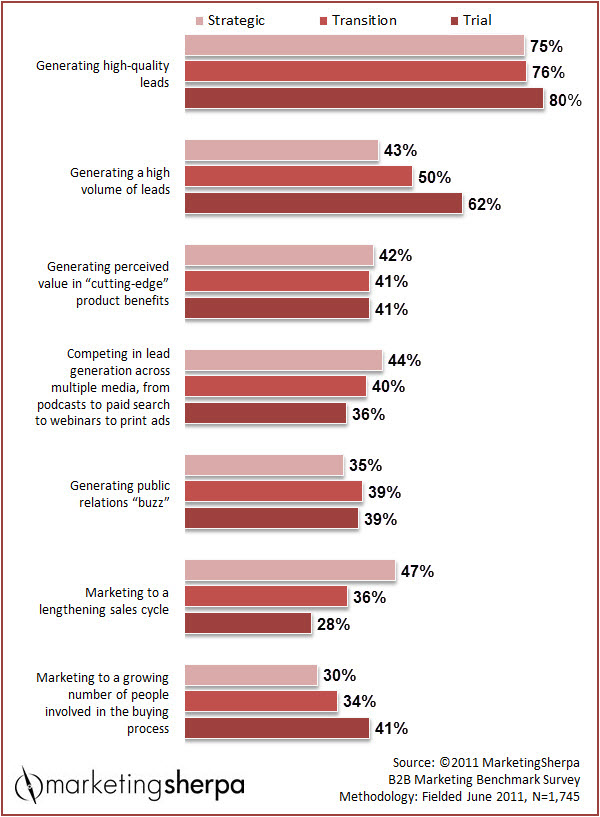
Click here to see a printable version of this chart
To help you understand the chart, in a previous Benchmark Report question, we asked marketers to describe the process their organization uses to plan, execute and measure the performance of lead generation, qualification, scoring, nurturing, hand-off/management and funnel optimization. The choices were:
- Strategic — Formal process, thorough guidelines, routine performance
- Transition — Informal process, few guidelines, sporadic performance
- Trial — No process or guidelines currently
All B2B marketers are challenged by generating high-quality leads
As you can see in the chart, generating high-quality leads is far and away the top challenge identified in the Benchmark Report.
While some challenges varied in importance based on marketing maturity — for example, 62% of trial-phase marketers were challenged by generating a high-volume of leads versus only 43% for strategic marketers; 47% of strategic marketers were challenged by marketing to a lengthening sales cycle, while only 28% of trial-phase marketers responded similarly — the spread was much tighter for this challenge, ranging from 80% of trial-phase marketers to 75% of strategic marketers recognizing this challenge.
So, we all know what the problem is … what is the solution?
Generating high-quality leads is an immensely difficult and complex problem to tackle, illustrated by the range of marketers recognizing this challenge. The ways to address it are equally varied and complicated. I don’t want to belittle the challenges you face every day in your job by touting an easy panacea — even if that tends to make for compelling article headlines that get shared widely across the Web.
My goal with today's Marketing Chart of the Week is to have you walk away and ask this question of yourself and your team …
How well do we perform the lead management blocking and tackling?
Let’s be frank, that's one of the most fun areas of the job and it's maybe even why you became a marketer. You get to forge partnerships, work with agencies on creative, even attend the Super Bowl if your budget and lead generation goals are big enough.
That would be all well and good if your only goal was generating mountains of leads. But, as you can see in the chart, that challenge is secondary to generating high-quality leads, because …
Sales doesn't want leads
Your CEO doesn't want leads, either. Also, your shareholders absolutely do not care about leads.They care about paying customers.
Therefore, contact information from someone who filled out a form, downloaded a white paper, signed up for an email, attended a webinar or fits a certain demographic profile in and of itself has no value.
It takes blocking and tackling. It takes lead management. It takes not just capturing the leads, but qualifying them, nurturing them and delivering them to Sales in an effective manner to create that value.
Yet, elsewhere in the Benchmark Report we found that only 22% of marketers find lead hand-off and management to be a challenge. More marketers see the challenge in pieces of the process like lead nurturing (40%), but less so in connecting all the pieces together that make for a successful process.
Perhaps that's because blocking and tackling isn't as popular as buzz-worthy tactics like social and mobile and QR codes.
Perhaps that's because marketers feel that CRM and marketing automation systems will do all of the work for them.
While these tools can be effective, the hammer is only as good as the carpenter wielding it.
So, let's end on this note. Ask yourself and your team if you are taking your lead management process for granted. Because, as this marketer responded in the Benchmark Report, the challenge will only become more difficult …
"The decision pipelines for higher-end products are becoming narrower and longer with more controls at the corporate level. The slower economy and company resistance to spending not only make budgets tighter but funnel management slower."
Related Resources
B2B Marketing Infographic: How are B2B marketers optimizing their funnel?B2B Marketing: 4 steps a systems integrator took to achieve Marketing-Sales alignment
B2B Marketing: How Cisco transformed its marketing strategy to better serve customers [Video]
Are Marketers' Campaigns Misaligned with customers expectations?
Tags:With an ever-growing list of channels for brands to connect with their audiences, it seems rational to expect that advertising and marketing campaigns are in a constant state of improvement. But what if these campaigns are fundamentally misaligned with consumer expectations? That was the question asked by marketing technology company x+1 and marketing research firm Research Now in their report, “The Marketer’s Playbook: Aligning market strategies with consumer expectations.†The companies surveyed consumers and marketers from companies of all sizes in the US in July 2013.
The poll found that one-quarter of consumers indicated they got the most help in making purchase decisions from messages delivered via email, making it the most valuable channel overall. But there was a sharp dropoff in the next channel, with only 16% of consumers seeing utility in messages coming through a personalized web experience. Mobile channels fared even worse in consumers’ estimation—6% thought mobile ads were useful, 5% said the same about mobile apps and only 2% thought SMS messages were helpful.
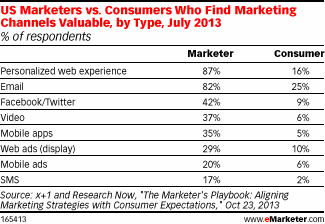
Marketers, meanwhile, appear to have significantly overestimated the value that various channels provide to customers and prospects. Fully 82% thought email was useful, while 87% saw the personalized web experience as helpful to customers—a far cry from the 16% of customers who felt that way. There were also significant gaps between marketers’ expectations about the usefulness of mobile apps, mobile ads and SMS as messaging channels, and the value that customers saw in them.
As staid as it may seem, email seems to serve marketers extremely well, as evidenced by consumers’ perceptions of it. Almost one-third of consumers thought email delivered relevant marketing messages, while three in 10 thought email messages were accurate, and just over one-quarter considered them memorable. While less consumers thought the personalized web experience was as memorable as email, a higher percentage of respondents thought personalized web was both more accurate and more memorable than email.
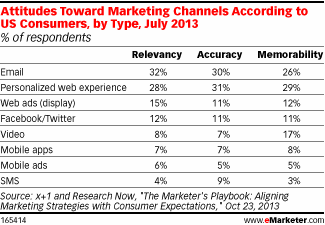
Clearly there exists a significant gap between marketers’ conceptions of the usefulness of various messaging channels and consumers feelings about them. In order to better bring the two into alignment, marketers can try to take advantage of various tools that allow them to solicit feedback and extract consumer usage data to help guide them in the right direction.
Reposted from eMarketer
Is it necessary for every page on my website to have A Meta Description? Google's Matt Cutts explains
Tags:Posted by William Cosgrove from Youtube
CALENDAR
CATEGORIES
TAGS
TWITTER POSTS
CALENDAR
- powered by
- One Big Broadcast
- creative by
- WebStager
© 2025 One Big Broadcast | All rights reserved

